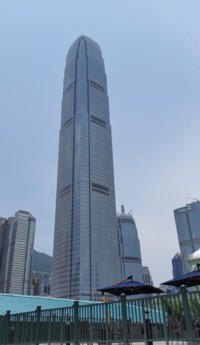Following our Japan trip in May 2017 we all returned to Hong Kong, after which Craig and Sonia headed home and Wendy and I headed to Shenzhen in China.
I have mentioned both these locations as a result of previous travels. They form what is effectively a single conurbation divided by the Hong Kong/Mainland border and this line also divides the population economically and in terms of population density.
These days there is a great deal of two way traffic between the two. It's very easy if one has the appropriate passes; and just a little less so for foreign tourists like us. Australians don't need a visa to Hong Kong but do need one to go into China unless flying through and stopping at certain locations for less than 72 hours. Getting a visa requires a visit to the Chinese consulate at home or sitting around in a reception room on the Hong Kong side of the border, for about an hour in a ticket-queue, waiting for a (less expensive) temporary visa to be issued.
With documents in hand it's no more difficult than walking from one metro platform to the next, a five minute walk, interrupted in this case by queues at the immigration desks. Both metros are world class and very similar, with the metro on the Chinese side a little more modern. It's also considerably less expensive. From here you can also take a very fast train to Guangzhou (see our recent visit there on this website) and from there to other major cities in China.
There are several pictures taken on the metro in Guangzhou in that album. Both the Shenzhen Metro and the Hong Kong MTR are similar from a commuter's standpoint. Everything is very modern with: good lighting and air-conditioning; platform glass barriers; lots of shiny metallic surfaces; lifts; and escalators.
The Guangzhou Metro (with 186 stations) is technically very similar those larger networks in Shanghai (364 stations)
and Shenzhen (with 199 stations). Hong Kong MTR has 93 similar rail and 68 integrated light rail (tram) stops
More about Trains - for those interestedAll China's trains use 'Standard Guage', unlike Australia's farcical differences between States. Most Mainland metros use 1,500 V DC, as do the majority of Hong Kong MTR tracks, while the older but also huge Beijing Subway (with 345 stations - growing steadily), employs only half that voltage, like the MTR light rail. 750V is safer in public streets but puts a limit on top speed, like Melbourne's trams on only 600V DC. Thus the newest and longest MTR lines, like the partially completed Hung Hom line, employ 25,000 V AC, in harmony with China Railway High-speed (CHR) services. These were originally based on Japan's Shinkansen (see Japan) and initially the train sets were imported from Japan but in 2004 public outrage over using Japanese manufactured rolling stock led to increased domestic production, in turn to independent technological development (still in cooperation with Kawasaki Heavy Industries). Now the 'China Standardized EMU' train-set, introduced in 2016, has a regular operational speed of 350 km/h (217 mph) but the CRH380BL train-set has attained a test speed of 487.3 km/h (302.8 mph), a considerable improvement on the Japanese train-sets. With eight horizontal and eight vertical lines, totalling 12,000 km, forming a rough grid over the map of China and regular operating speeds of up to 400km/h China's is by far the most extensive and advanced high speed rail network in the world. |

